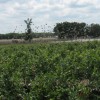 Many improved southern highbush cultivars have been developed by the University of Florida breeding program since the initial releases of ‘Sharpblue’, ‘Flordablue’, and ‘Avonblue’ in the mid-1970s. Today there are more blueberry cultivar choices available for Florida growers than ever before, but in every case, cultivar selection involves weighing the advantages and disadvantages of a cultivar relative to the grower’s needs. Unfortunately, there are no perfect cultivars suited for every location and management system. This 10-page fact sheet categorizes southern highbush cultivars into four groups: major cultivars, secondary cultivars, new options, and historical cultivars. Proper cultivar selection is critical to a successful blueberry enterprise, and growers should seek information from multiple sources, including their local county Extension office. Written by J.G. Williamson, J.W. Olmstead, G.K. England, and P.M. Lyrene, and published by the UF Department of Horticultural Sciences, April 2014.
Many improved southern highbush cultivars have been developed by the University of Florida breeding program since the initial releases of ‘Sharpblue’, ‘Flordablue’, and ‘Avonblue’ in the mid-1970s. Today there are more blueberry cultivar choices available for Florida growers than ever before, but in every case, cultivar selection involves weighing the advantages and disadvantages of a cultivar relative to the grower’s needs. Unfortunately, there are no perfect cultivars suited for every location and management system. This 10-page fact sheet categorizes southern highbush cultivars into four groups: major cultivars, secondary cultivars, new options, and historical cultivars. Proper cultivar selection is critical to a successful blueberry enterprise, and growers should seek information from multiple sources, including their local county Extension office. Written by J.G. Williamson, J.W. Olmstead, G.K. England, and P.M. Lyrene, and published by the UF Department of Horticultural Sciences, April 2014.
http://edis.ifas.ufl.edu/hs1245
Tag: J.W. Olmstead
Reproductive Growth and Development of Blueberry (HS976/HS220)
 This 7-page fact sheet discusses flower bud initiation and development, pollination and fruit set, fruit development and yeild, and the use of plant growth regulators. Written by J. G. Williamson, J. W. Olmstead, and P. M. Lyrene, and published by the UF Department of Horticultural Sciences, February 2012.
This 7-page fact sheet discusses flower bud initiation and development, pollination and fruit set, fruit development and yeild, and the use of plant growth regulators. Written by J. G. Williamson, J. W. Olmstead, and P. M. Lyrene, and published by the UF Department of Horticultural Sciences, February 2012.
http://edis.ifas.ufl.edu/hs220
Florida’s Commercial Blueberry Industry (HS742/AC031)
 The Florida blueberry industry has grown rapidly because Florida growers can produce high-quality fruit when few fresh berries are available and berry prices are high. Although southern highbush blueberry acreage has expanded significantly in Florida, Georgia, California, and Mexico during the last several years, better cultivars and improved cultural practices have increased grower production efficiency during the last several years, with promising production trends for the future profitability. This 4-page fact sheet was written by J. G. Williamson, J. W. Olmstead, and P. M. Lyrene, and published by the UF Department of Horticultural Sciences, February 2012.
The Florida blueberry industry has grown rapidly because Florida growers can produce high-quality fruit when few fresh berries are available and berry prices are high. Although southern highbush blueberry acreage has expanded significantly in Florida, Georgia, California, and Mexico during the last several years, better cultivars and improved cultural practices have increased grower production efficiency during the last several years, with promising production trends for the future profitability. This 4-page fact sheet was written by J. G. Williamson, J. W. Olmstead, and P. M. Lyrene, and published by the UF Department of Horticultural Sciences, February 2012.
http://edis.ifas.ufl.edu/ac031
Protecting Blueberries from Freezes in Florida (HS968/HS216)
 Blueberry growers: know when the conditions are right in commercial blueberry fields, during and after bloom, for freeze damage, as well as practices you can use to minimize it. This 7-page fact sheet was written by J.G. Williamson, P.M. Lyrene, and J.W. Olmstead, and published by the UF Department of Horticultural Sciences, January 2012.
Blueberry growers: know when the conditions are right in commercial blueberry fields, during and after bloom, for freeze damage, as well as practices you can use to minimize it. This 7-page fact sheet was written by J.G. Williamson, P.M. Lyrene, and J.W. Olmstead, and published by the UF Department of Horticultural Sciences, January 2012.
http://edis.ifas.ufl.edu/hs216
Blueberry Gardener’s Guide (CIR1192/MG359)
 Home gardeners: Use this guide to successfully grow blueberries in Florida. This 8-page fact sheet was written by J.G. Williamson, P.M. Lyrene, and J.W. Olmstead, and published by the UF Department of Horticultural Sciences, January 2012.
Home gardeners: Use this guide to successfully grow blueberries in Florida. This 8-page fact sheet was written by J.G. Williamson, P.M. Lyrene, and J.W. Olmstead, and published by the UF Department of Horticultural Sciences, January 2012.
http://edis.ifas.ufl.edu/mg359